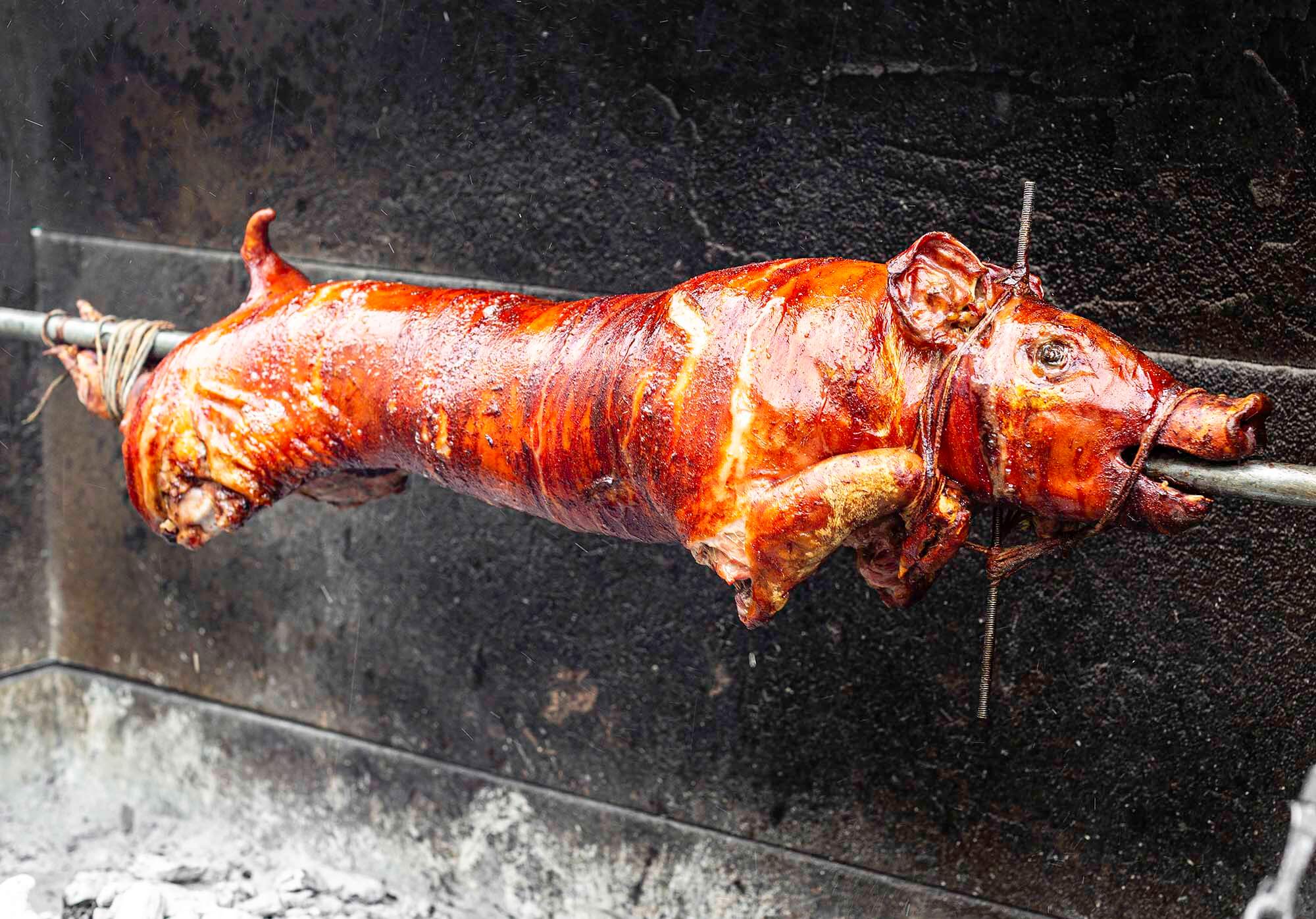A holiday pig roast is popular in many Latino households.
When most Latinos see a lechón, or suckling pig, it can only mean one thing: It’s the holiday season and time to gather in large numbers with family and friends.
In Northern Nevada, options to taste the juicy cochinillo (another Spanish word for a young pig) and crunch on the crispy pork skin are not as difficult to find as you might think. Just grab an arepa de lechón (similar to tacos but made with corn flatbread) from Venezuelan food truck Arepeichón in Sparks (or wherever its Instagram tells you it’ll be any given weekend). Or try the traditional family recipe below, courtesy of The Ritz Carlton, Lake Tahoe chef/kitchen supervisor John Taboas, who is a Reno-based Puerto Rican. And if you are ready to try this recipe on your aunts and uncles, between Marketon in Reno and Manila HongKong Store & Kitchen in Sparks, you’ll find the products you need to impress la familia.
What makes lechón so special for events? It’s the painstaking process of giving it the tender loving care needed not to burn the skin and/or dry out the meat. Luckily, lechón doesn’t require many ingredients (which probably explains the many variations by West Africans, Chinese, Filipinos, and Hawaiians). The most expensive item will be the pig, which essentially pays for itself, as it can feed as many as 50 people. Now that’s how you throw a fiesta!
After the entrails are removed, the piglet is skewered and slowly rotated by hand as it cooks over intense heat for seven to eight hours. A wood fire is preferred by Taboas, to avoid getting other flavors, such as fuel, into the meat. This is when your besties, with cold cervezas in hand, step in to help spin the pig, rotisserie-style, nonstop until the skin turns a crispy brown the color of chicharrón (fried pork belly or pork rind) and the juicy interior comes apart on your fork. There are faster ways to roast the suckling pig, such as using La Caja China — a wooden box with a metal interior used with charcoal to cook the pig in roughly half the time — or an oven, but the traditional method is to cook the skewered pig over a fire pit, according to Taboas, which keeps the meat juicy.
Taboas recommends giving the suckling a salt rub three days before you begin cooking, as well as frequently spraying the pig with salt water as it spins over the fire pit — both actions help to keep the pig moist. A sunrise cooking start means the lechón could be ready by 1 p.m., just in time for an afternoon celebración!
RESOURCES
Ready to buy your own suckling pig and have lechón for your next gathering? Find it at these local stores.
Arepeichón
Instagram.com/arepeichon
Check the business’ Instagram every week to locate the food truck and taste its lechón arepa.
Manila HongKong Store & Kitchen
2233 Oddie Blvd., Sparks
775-331-7877 • Manilahkstore.com
Here you can find a completely cooked lechón for $425.
Marketon
1500 S. Wells Ave., Reno
775-786-8788 • Marketon.com
Marketon sells the whole raw carcass for about $199 total, which is a fantastic deal if you can find friends to pitch in with the cooking.
Puerto Rican-Style Lechón
(courtesy of John Taboas, chef/kitchen supervisor, The Ritz-Carlton, Lake Tahoe. Serves 35 to 40)
1 raw 35- to 60-pound suckling pig
4 cups fresh oregano leaves
8 cups salt
2 cups ground black pepper
To keep the meat moist, 72 hours before your event, place pig in a large roasting pan and rub 4 cups salt all over pig. Leave on for 24 hours, then rinse. Cover pig with dry adobo rub made of oregano, remaining 4 cups salt, and ground black pepper.
On the morning of the roast, remove pig from pan, skewer, and cook over fire pit. Use a spray bottle filled with salt water to repeatedly spritz on the pig while it spins rotisserie-style for 7 to 8 hours.
If roasting pig in an oven, set it to 350 degrees F. The cook time will depend on the weight of the pig, but around 3 hours. (There is no need to spritz salt water on pig if cooking in oven.) The standard rule of thumb is 1 hour of cooking for every 7 to 10 pounds of meat. The goal is to get crispy, brown skin.
Tip: Taboas recommends serving your lechón with sides such as rice mixed with pigeon peas, maduros (fried sweet plantains), potato or macaroni salad, and a delicious flan. Save the leftovers for sandwiches and arepas. Enjoy!


